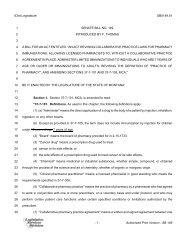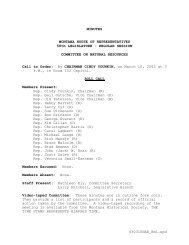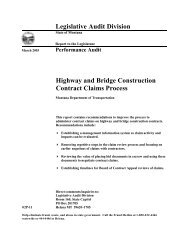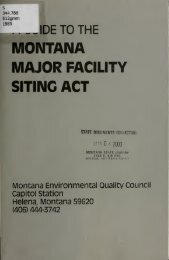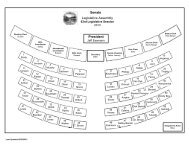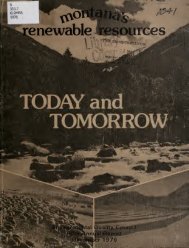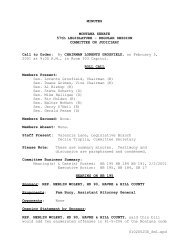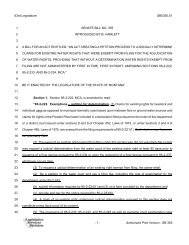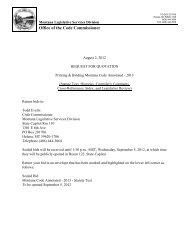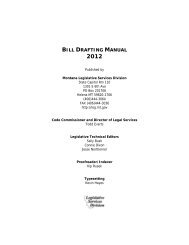Public Comment. Volume III - Montana Legislature
Public Comment. Volume III - Montana Legislature
Public Comment. Volume III - Montana Legislature
You also want an ePaper? Increase the reach of your titles
YUMPU automatically turns print PDFs into web optimized ePapers that Google loves.
BROWN LAW F w P.C.<br />
Page 3<br />
April 1 1,2000<br />
2. Condemnors should be restricted fiom transferring use interests in condemned<br />
property to third parties for any other uses which are beyond the primary use for<br />
which the condemnors' interests were acquired.<br />
. . This-particular concern has arisen because condemnors have acquired the right to lay<br />
fiber optic cables, ostensibly for their own use, and then have sold the rights to third party cable<br />
companies to install additional fiber optic lines or use the fiber optic lines installed by the<br />
condmenors. When confronted by this, condemnors, which have acquired fee simple title to a<br />
ribbon of land through ranch and farm land or an unrestricted easement, take the position that its<br />
nobody's business, if third parties are allowed to use the condemned land. Many of these<br />
condemnors have receive handsome fees fiom third parties without any remuneration to the<br />
underlying land owner.<br />
It goes without saying that underlying land owners have not been told that third parties<br />
will also burden their land. The only things under lying land owners or courts, for that matter, are<br />
normally told about, are the needs of condemnors. To expand the use, beyond that which has<br />
been represented to the underlying landowners, is an added burden to the underlying land owner's<br />
property. This added burden exists whether the taking is in fee or by easement- - as an example,<br />
the more use made of a fiber optic cable by third parties the sooner that cable will need to be<br />
replaced or a new one placed along side it. That site work will necessarily impact the underlying<br />
land owners' property. Another example is the situation, where a third party is given iidependent<br />
rights of maintenance and replacement side by side with the same rights, retained by the<br />
condemnor. In this last example multiple companies could be performing maintenance and<br />
replacement work during the same periods of time. Land owners should not be subjected to these<br />
added third party uses, unless prior to the taking, these uses are specifically addressed as<br />
condemnor's primary needs.<br />
The law needs to be clarified so that condemned property may only be used for the<br />
primary purpose for which it acquired and no other. If the condemnor sells all or part of its<br />
primary business, requiring the use of the condemned property, the assignee should be allowed to<br />
acquire rights in the condemned property. To allow the condemnor to do anything more than that<br />
would not be in keeping with the public policy that the condemnor only be allowed the least<br />
definable taking which will still allow the condemnor to reasonably hlfill its needs. The needs of<br />
third parties aren't the needs of the condemnor.<br />
The limitation on transfers for third party use should be required by a separate statute<br />
which covers both court decisions and negotiated takings. It should be made clear that a taking<br />
by the federal government or the state and local governments for highway purpose have no such<br />
limitation in order to assure the continued use of the highway systems for use by various beneficial<br />
utilities.<br />
-62- <strong>Volume</strong> Ill: <strong>Public</strong> <strong>Comment</strong>



